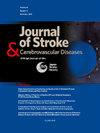Immune checkpoint inhibitor-related CNS vasculitis – A systematic review and report of 6 cases
IF 2
4区 医学
Q3 NEUROSCIENCES
Journal of Stroke & Cerebrovascular Diseases
Pub Date : 2025-02-19
DOI:10.1016/j.jstrokecerebrovasdis.2025.108265
引用次数: 0
Abstract
Background
Immune checkpoint inhibitors (ICI) represent an important new class of immunotherapy used in cancer treatment. Though effective, immune-related adverse events (irAE) are reported, including cerebral vasculitis (nirVasculitis). In this systematic review, we aim to identify clinical and laboratory features of nirVasculitis and exemplify these in six local clinical cases.
Observations
We followed the Preferred Reporting Items for Systematic Reviews and Meta-Analyses (PRISMA) guidelines. Two independent researchers searched, identified, and extracted data from both PubMed and Embase to identify reports on nirVasculitis. Based on current criteria for diagnostic certainty patients were categorized as having definite, probable, or possible nirVasculitis. 20 cases described relevant symptomatology and met our inclusion criteria. Non-small-cell lung cancer (55 %) was the most frequent cancer type. Most cases (95 %) received a programmed death-1 (PD-1) inhibitor. One patient had definite vasculitis, seven probable vasculitis, and twelve possible vasculitis. Signs and symptoms included aphasia (n = 5), loss of consciousness (n = 7), confusion (n = 8), unilateral sensory or motor dysfunction (n = 5), and fever or headache (n = 9). All patients had brain imaging and seventeen underwent a lumbar puncture. Of these, 64.7 % had pleocytosis and 52.9 % elevated protein in cerebrospinal fluid. Nineteen patients received corticosteroids. Eight patients fully or partially recovered. Eight patients died due to nirVasculitis, three to advanced cancer, and one lost to follow-up.
Conclusions
There are few clinical reports of nirVasculitis which may be due to underreporting or rarity of complications. Guidelines for diagnostics and reporting may improve awareness and early recognition to initiate important immunosuppressive treatment.
免疫检查点抑制剂相关的中枢神经系统血管炎- 6例的系统回顾和报告
背景:免疫检查点抑制剂(ICI)是一类重要的新型免疫疗法,用于癌症治疗。虽然有效,但免疫相关不良事件(irAE)也有报道,包括脑血管炎(nirVasculitis)。在这篇系统综述中,我们的目的是确定非血管炎的临床和实验室特征,并在六个当地临床病例中举例说明这些特征。观察:我们遵循了系统评价和荟萃分析(PRISMA)指南的首选报告项目。两名独立的研究人员从PubMed和Embase检索、识别和提取数据,以确定关于非血管炎的报告。根据目前诊断确定性的标准,将患者分为明确的、可能的或可能的非血管炎。20例描述了相关症状并符合我们的纳入标准。非小细胞肺癌(55%)是最常见的癌症类型。大多数病例(95%)接受程序性死亡-1 (PD-1)抑制剂治疗。1例明确血管炎,7例可能血管炎,12例可能血管炎。体征和症状包括失语(n=5)、意识丧失(n=7)、意识模糊(n=8)、单侧感觉或运动功能障碍(n=5)、发热或头痛(n=9)。所有患者均行脑显像,其中17例行腰椎穿刺。其中64.7%有多细胞增多症,52.9%脑脊液蛋白升高。19名患者接受了皮质类固醇治疗。8例患者完全或部分康复。8例患者死于非血管炎,3例死于晚期癌症,1例失访。结论:临床报道的非血管炎病例很少,这可能是由于并发症少报或罕见所致。诊断和报告指南可以提高认识和早期识别,以启动重要的免疫抑制治疗。
本文章由计算机程序翻译,如有差异,请以英文原文为准。
求助全文
约1分钟内获得全文
求助全文
来源期刊

Journal of Stroke & Cerebrovascular Diseases
Medicine-Surgery
CiteScore
5.00
自引率
4.00%
发文量
583
审稿时长
62 days
期刊介绍:
The Journal of Stroke & Cerebrovascular Diseases publishes original papers on basic and clinical science related to the fields of stroke and cerebrovascular diseases. The Journal also features review articles, controversies, methods and technical notes, selected case reports and other original articles of special nature. Its editorial mission is to focus on prevention and repair of cerebrovascular disease. Clinical papers emphasize medical and surgical aspects of stroke, clinical trials and design, epidemiology, stroke care delivery systems and outcomes, imaging sciences and rehabilitation of stroke. The Journal will be of special interest to specialists involved in caring for patients with cerebrovascular disease, including neurologists, neurosurgeons and cardiologists.
 求助内容:
求助内容: 应助结果提醒方式:
应助结果提醒方式:


